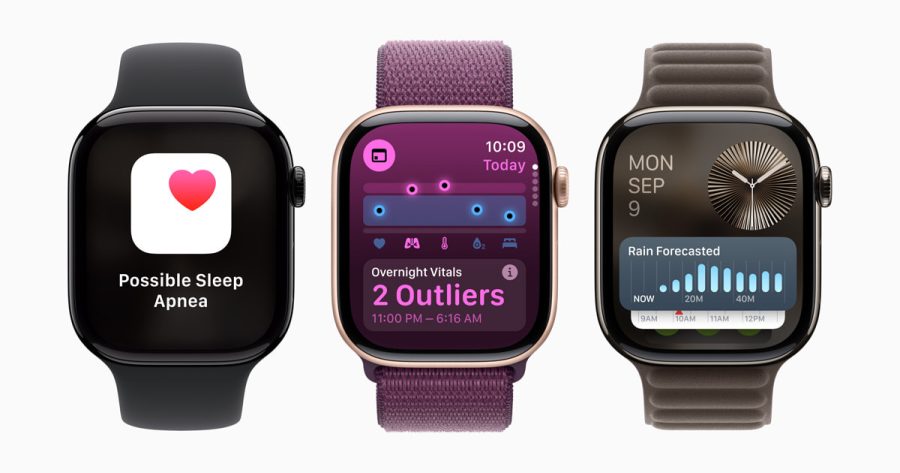Opens in a new window
The Apple Watch Series 10 made its debut on Monday, with the tech giant unveiling the Series 9‘s successor at its event in California.
This year’s Apple Watch is powered by the company’s new S10 System in Package (SiP), which certainly sounds like a step up compared to the Series 9’s S9 SiP. Even so, most of the differences between the Apple Watch Series 10 and 9 appear relatively incremental.
Here’s a comprehensive comparison between the Apple Watch Series 10 and 9 to help you decide whether to upgrade.
Apple Watch Series 10 vs. 9: Price
When investing in a new piece of tech, one of the biggest considerations is the price. The new Apple Watch Series 10 starts at $399, which will snag you the 42-millimetre aluminium option with just GPS. The price jumps up to $699 if you switch to titanium, which comes with both GPS and cellular connectivity, topping out at $749 if you also choose the larger 46-millimetre size.
In comparison, the Apple Watch Series 9 also started at $399 at launch, however its price has dropped in the year since. The smallest 41-millimetre Series 9 in aluminium with only GPS is currently available for $274.77, while the 45-millimetre stainless steel option with both GPS and cellular can be picked up for $649.
Featured Video For You
That’s a difference of approximately $100 between last year’s Apple Watch and this year’s equivalent models. Whether it’s worth it will depend on your priorities.
Apple Watch Series 10 vs. 9: Display
Credit: Apple
Both the Apple Watch Series 10 and 9 boast a brightness range from one to 2000 nits, so there aren’t any changes there. However, the Series 10’s one-millimetre increase across its two size options isn’t the only difference to its display.
The Series 10 upgrades the Series 9’s low-temperature polycrystalline oxide (LTPO) display to LTPO3, the latest version of this technology. This should mean an increase to the Series 10’s variable refresh rate and power efficiency, offering a smoother display that’s less draining on the battery. Even so, exactly how much of a practical, noticeable difference this will make isn’t clear, especially as the Series 10 doesn’t claim any increase in battery life (more on that below).
Another change is the Series 10’s new wide-angle organic light-emitting diode (OLED), making it the first Apple Watch with this feature. This wide-angle OLED enables pixels to emit more light at a wider angle, with Apple claiming the Series 10 offers a 40 percent increase in brightness when viewed from an angle over the Series 9.
The company further states that the OLED’s improved power efficiency has allowed the Series 10’s refresh rate in always-on mode to increase to once per second, a notable jump from the Series 9’s rate of once per minute. As such, some Watch faces will allow wearers to see a ticking seconds hand without having to raise their wrist.
Apple Watch Series 10 vs. 9: Design
Credit: Apple
Straight off the bat, the Apple Watch Series 10 is slightly larger than the Series 9, offering 46 and 42-millimetre models as compared to last year’s 45- and 41-millimetre models. However, it has shaved off some bulk in other areas.
One of the most prominently spruiked changes to the Apple Watch Series 10’s design is that it’s slimmer. Apple claims that the Series 10 is almost 10 percent thinner than the Series 9, shaving one millimetre off to take it from 10.7 to 9.7 millimetres thick. That may not seem like much, but every little bit counts when you’re measuring in millimetres.
The Series 10 is also lighter, though the difference here will depend on which models you’re comparing. Apple states that the Series 10’s aluminium models are up to 10 percent lighter than those in Series 9, while the titanium models are almost 20 percent lighter than last year’s stainless steel.
Judging from the specifications shared by Apple, this seems about right. The lightest Series 10 Watch is the 42-millimetre aluminium model with GPS and cellular, which Apple states weighs 29.3 grams. In comparison, the lightest Series 9 Watch is the 41-millimetre aluminium with GPS only, which comes in at 31.9 grams — 2.6 grams heavier. The Series 10’s titanium also comes out lighter when compared to the Series 9’s stainless steel. Its heaviest option is the 46-millimetre titanium model weighing 41.7 grams, which is almost 10 whole grams lighter than the heaviest stainless steel Series 9 at 51.5 grams.
In addition to these changes, the Series 10’s corners are more rounded and it has a wider aspect ratio than Series 9. Apple states that these tweaks to the Watch’s form factor enable a notably larger display.
Credit: Apple
Finally, there’s the Apple Watch Series 10’s colour options to go through. The colour of a new Apple Watch is arguably even more important than that of a new iPhone, since you’re much more likely to cover the latter with a phone case anyway.
At launch, the Series 10 comes in six different colours equally distributed between its aluminium and titanium models. The aluminium Series 10 is available in jet black, rose gold, and silver, while the titanium version comes in slate, gold, and natural.
In comparison, the Series 9 has five colours for its aluminium model alone — midnight, starlight, silver, pink, and (PRODUCT)RED). Its stainless steel model has three with graphite, silver, and gold, or four if you include the Apple Watch Hermès collaboration’s space black.
Apple Watch Series 10 vs. 9: Health and fitness features
Credit: Apple
Apple announced a new sleep apnea feature with the Series 10, which uses the Watch’s accelerometer to monitor your sleep and notify you if it detects signs of the sleep disorder. However, this feature doesn’t separate the Apple Watch Series 10 from the 9, as this Breathing Disturbances metric will be coming to both models and the Ultra 2 this month.
A better way to distinguish the two is via their oceanic capabilities. The Series 10 is more equipped for aquatic adventures than the Series 9, featuring both a water temperature sensor and a depth gauge capable of tracking up to 20 feet (six metres) down. Information gathered by these features is displayed via Apple’s Depth app, which comes preloaded on the Series 10. The latest Apple Watch is compatible with the Oceanic+ snorkelling app as well, though unlike the Depth app you’ll have to head to the Apple App Store to download it.
The Series 9 doesn’t have such functionality, so it’s a factor to consider if you’re an avid snorkeler and iPhone user who doesn’t already have an Ultra.
Apple Watch Series 10 vs. 9: Audio
Audio is far from the first feature people think of when they think about Apple Watches. Even so, the new Apple Watch Series 10 is improving its audio capabilities by allowing music to be played through its inbuilt speaker.
While the Series 9 also has a speaker, it’s restricted to utilitarian uses such as phone calls, the Walkie-Talkie function, and Voice Feedback during your workouts. In contrast, the Series 10 will let you play media such as music, podcasts, and audiobooks, enabling you to irritate everyone around you by blasting tunes directly from your wrist. This will work with Apple apps such as Apple Music, Podcasts, and Books, as well as third-party apps.
The Apple Watch Series 10 also upgrades its microphone’s capabilities by adding voice isolation, using a neural network to reduce background noise during calls.
Most people aren’t searching for audio capability when buying a watch. You’ll probably still prefer to use your iPhone or a pair of AirPods for your calls and music, only turning to the Apple Watch when they aren’t at hand or if you’re in an emergency. Still, it is technically an improvement over the Series 9.
Apple Watch Series 10 vs. 9: Battery life
Apple doesn’t claim any difference in battery life between the Watch Series 10 and 9. Both run on a rechargeable lithium-ion battery, which the tech giant says offers up to 18 hours of juice (or 36 in low power mode). Both are fast charge capable as well.
However, Apple does state that the Series 10’s charging coil is larger and more efficient, allowing you to charge up your Watch’s battery from zero to 80 percent full in 30 minutes. That’s an improvement over the Series 9, which Apple has said needs 45 minutes to get to 80 percent. Fifteen minutes doesn’t seem like a terribly significant difference though.
Mashable will be testing Apple’s new Watch and provide an update with the results, but for now it looks as though battery life isn’t a major factor to agonise over if you’re deliberating between the Series 10 and 9.




























